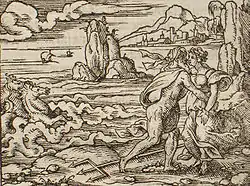Caeneus
In Greek mythology, Caeneus /ˈsɛnˌjuːs/ SEN-yoos (Ancient Greek: Καινεύς Kaineús) was a Lapith hero of Thessaly. According to Book XII of Ovid's Metamorphoses, he was originally a woman,[1] Caenis (/ˈsiːnɪs/), daughter of Atrax.

In Apollonius of Rhodes' Argonautica,[2] he is briefly noted as the great father of a lesser son, Coronus, who sailed forth among the Argonauts.[3] Caeneus was also an Argonaut in some versions. The striking mythic image of this hero is that, indomitable through his more-than-human power, his enemies the Centaurs resorted to driving him into the ground with timbers.[4]
|
Myth
Caenis was a woman who was abducted and raped by the god Poseidon, who had also raped Medusa and caused her to be cast out by her patroness Athena.[6] After raping Caenis, Poseidon was pleased and promised to grant Caenis a wish. Caenis was so distraught that she demanded to be changed into a man, so that she might never be wronged again.[7] Poseidon granted this wish, and also gave Caenis impenetrable skin. Thereafter, the spelling of Caenis was changed to Caeneus to mark his transformation.
Caeneus is said to have died in the battle between the Lapiths and the centaurs (see Pirithous). Similarly, in the Iliad (without referring to these transformations) Nestor numbers Caeneus among an earlier generation of heroes of his youth, "the strongest men that Earth has bred, the strongest men against the strongest enemies, a savage mountain-dwelling tribe whom they utterly destroyed".
In Ovid's description of the tale, a particular centaur, Latreus, mocks Caeneus and denies his skill as a fighter when he realizes that Caeneus is originally female. Caeneus strikes Latreus a blow in the side, and is unharmed by the centaur's last attempts at wounding him. In revenge for this, the centaurs piled pine-tree trunks (some say fir trees) and stones upon him, since he was immune to weapons.
There are several descriptions of Caeneus' fate after he had been crushed down by the trunks. One vase, for instance, depicts him as sinking down into the earth, upright, and buried at the waist; this legend is described in Ovid's Metamorphoses as well, and implies that Caeneus is falling directly into Tartarus. Ovid states that Caeneus flew away from the pile of tree trunks as a golden-winged bird. This version of the ending is given by two witnesses, Mopsus and the "son of Ampycus", as well as Nestor, who tells the story.[8]
Caeneus' legend is found in Metamorphoses, where he is mentioned briefly as a participant in the hunt for the Calydonian Boar. Some time after this appearance, Nestor tells the story of Caeneus to Achilles in fuller detail, describing his transformation from female to male. In Ovid's retelling, placed in the mouth of the aged Homeric hero Nestor, Caenis, the daughter of Elatus (a Lapith chieftain) and Hippea, was raped by Poseidon, who then fulfilled her request to be changed into a man so that she could never be raped again; he also made Caenis invulnerable to weaponry. Caenis then changed his name to Caeneus and became a warrior, traveling all over Thessaly, and later taking part in the hunt for the Calydonian Boar.[9]
Virgil also says that Aeneas sees him, having been returned to his original female form by the Fates, in the Fields of Mourning as he visits the underworld in Book Six of the Aeneid. He was also mentioned in the Hesiodic Catalogue of Women.[10]
Notes
- Ovid, Metamorphoses XII.170ff, 459ff
- Apollonius Rhodius, Argonautica I. 56-64.
- Sophia Papaioannou, Redesigning Achilles: 'Recycling' the Epic Cycle in the 'Little Iliad': (Ovid, Metamorphoses 12.1–13.622), (Untersuchungen zur antiken Literatur und Geschichte, 89) Berlin/New York: Walter De Gruyter, 2007, divides the Argonauts among "Orphics" and "Heracleans", those of skill and those of brute strength: Caeneus is among the Heracleans. Ovid's story of the transsexual Caeneus "revisits and reverses the gendered polarity of traditional epic", according to Ioannis Ziogas (Cornell University), reviewing Papaioannu in Bryn Mawr Classical Review 2008.
- "Caeneus, struck by the green fir-trees, cleft the ground with his foot, where he stood, and passed beneath the earth." (Pindar, Frag. 16, noted at Theoi Project, which illustrates an Attic vase-painting depicting the centaurs also using boulders to crush Caeneus. Ovid mentions oaks.
- Peter Green, The argonautika(1997) 2007:44f.
- Ovid, Metamorphoses XII.195-199
- Ovid, Metamorphoses XII.203ff
- Papaioannou, Sophia (2007). Redesigning Achilles. Walter de Gruyter GmbH & Co. KG, 10785 Berlin, Germany.: Deutsche Nationalbibliothek. p. 120. ISBN 978-3-11-020048-5.CS1 maint: location (link)
- Metamorphoses XIII
- Hesiod, Catalogue of Women fr. 87.
References
- Gardner, Ernest (1897). "Caeneus and the Centaurs: A Vase at Harrow" (PDF). The Journal of Hellenic Studies. The Society for the Promotion of Hellenic Studies. 17: 294–305. doi:10.2307/623831. JSTOR 623831.
- Françoise LECOCQ (2013). « Caeneus auis unica (Ovide, Mét. 12, 532) est-il le phénix ? ». Le phénix et son Autre. Poétique d'un mythe, dir. L. Gosserez, Presses Universitaires de Rennes, collection Interférences, p. 211-220.
- Homer, Iliad, I, 262–8
- Ovid, Metamorphoses VIII, 305; XII, 171–209 and 459–525
- Pseudo-Apollodorus, Epitome I, 22
- Virgil, Aeneid VI, 448–9.
External links
| Wikimedia Commons has media related to Caeneus. |
- Encyclopædia Britannica, s.v. "Caeneus"
- Images of Caenis/Caeneus in the Warburg Institute Iconographic Database
